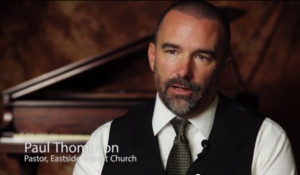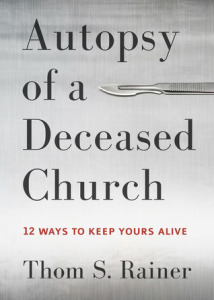(Book Review of “Autopsy of a Deceased Church” part 2. here is part 1)
The chapters are short, this make the reading easy and convenient for a day that can be broken up into short bite sized moments of reading. The reader can knock out parts of the book quickly or take smaller parts of it and reflect on the impact. Here are some quick observations of the next several chapters (good, bad and ugly parts).
Have you heard the one about “how many baptists does it take to change a light bulb?” CHANGE! did somebody say CHANGE?
We may own the implications of that stereotype, but I think we use the language of change in a dangerously risky way. The impact may achieve a startling reality check. But, I think the use of the word ‘change’ is the wrong word to use sometimes. In the chapters reviewed thus far, I get what Rainer is exposing, I just wish more care could be given to the use of the word ‘change’.
Why don’t church health books talk about repentance rather than change?
I will attempt to review critically, honestly, and carefully. This is where, if I’m not careful, I can get too critical.
Chapter 2: Slow Erosion
Do you ever return to a town you once lived in after many years of absence? True, a lot can be told of the economical condition of the region by what’s going on or not going on.
That’s true of a city.
My question would be; is that true of a church?
I think that it could be true. But what is the examination telling us? Is it noticing a decay in health or a decay in activity. I do not think the two are as interchangeable as it is purported many times. Empty rooms today may not mean a decay in health, it may, but it’s not a hard fast rule.
If it has been over 25 years since you drove through Twin Falls, Idaho my first question would be; Where have you been? Then you would notice a major shift in the city. Blue Lakes Blvd. may still be the main business route in town, but business has been shifting and moving. Go back even farther in the history of the city and you would find that the main business route has been shifting since the beginning. Not meaning unhealthy, just changing. It would likely be more noticeable in a smaller town than a place like Twin Falls, and the analogy is complicated here because city and county population here has been growing at a steady pace for many decades.
There is a lot to be said about a building. I’ve been in places that have the appearance of decay that are quite alive and I’ve been in places where the grounds and building are in prime condition, attendance has the appearance of strength and there is actually little spiritual life at all.
I appreciate what Rainer is showing, but I found the ambiguous conclusion risky for any reader. Especially a reader who is prone to the shifting winds that come with the language of “change.” This simple word is a dangerous word for churches and pastors. It’s not so much that either resist change, I think it’s more that they both thing that change is the solution to their perceived problem they pick up by reading a book. Sure, a dangerous pit for a church and pastor to be in is a pit full of pride that everything is fine and no need to change.
What would happen if the author used the biblical word, repent?
I don’t find the Lord calling his church to change, I hear the language of repentance to individuals, churches and nations.
I’m nearing a longer word count than the actual chapter I’m reviewing so I’ll close up my thoughts and ponder it a bit more with prayer and boldness from the points and questions Rainer brings up.
Chapter 3: The Past is the Hero
I think Rainer does a good job of articulating the meaning behind his use of the word ‘change.’ He’s meaning more the nostalgia of the past.
I think this was helpful for me in this respect, there are indeed things of the past that we all want repeated because it was a a special occasion. It brought about an emotion of significance, it marked a moment where adjustments were made or note worthy change in behavior took place.
It’s like many things related to the Christmas season.
At Eastside, when I first came, we did an event called the hanging of the greens. It was a tradition. It was well attended. It involved people and families that normally didn’t participate in regular church life.
It had great results, but there were few things that caused more trouble for me as pastor as this once-a-year event. Change was sure to come in how the event was handled, planned and executed. But it came slowly and painful.
We still decorate the auditorium for Christmas, but it’s a different auditorium and accomplished differently. There was literally no other event that generated more in attendance than that one event with greater disappointment in the result of the participant or attendee. This isn’t me being critical of the event or the organizers, this is an honest examination of the past. Many people talked about that great event, but there was little spiritual impact.
I get what Rainer is arguing for. That was an examination of a very popular event that was more about sentiment than doctrinal fidelity.
I still want to argue that the better word here is repent.
Anytime an individual or church replaces faith in the sufficiency of Christ with sentiment for an event or program they are in a dangerous place of offending God with their sentimental love for the hero of the past.
The same issues are argued in many churches about the ‘changing’ winds of music style, order of service, time of the gatherings, length of the service, the frequency or infrequency of something. There are many things that can be changed and doesn’t have impact on doctrine.
Chapter 4: The Church Refused to Look Like the Community
Here’s where I begin to fall into my typical cynical self. I don’t even like the title of the chapter. I found myself reading it looking for my bone of contention. I was pleasantly pleased that Rainer was not arguing for typical relevance or the church caving to the demands of the community.
His point in this simple chapter was an honest evaluation of how the church was actually reaching the neighborhood it is physically planted in. This is likely more of an urban issue than a rural matter where neighborhoods change over time. The once new neighborhood takes on a shift as other places in the city become the new neighborhoods.
There are valid points he makes about how the local church reflects the actual physical community.
I still wish there would be more clarity from the ‘field expert’. I don’t think Rainer is meaning that a church should ask the community what they want in a church. But when clarity is not given, the reader has a tendency to read into the message. I may be wrong, but I argue that Rainer knows that a church is not commissioned of God to discover what a community wants from a church as a means to grow a church. She has her orders from God to be a pillar and buttress of truth in the community. She’s not to be driven by fads and trends of churches trying to mask healthiness. She must love the community enough to be a tower of truth.
I don’t like the idea of niche churches. A church for this group, a church for this group, another church for this group. This mentality creates a self-interested church that will not survive a changing community. The only church that can really survive a changing community is a church that stays her ground and doesn’t forget her duty. Obviously this can be lost in the day too. If care is not given, this church becomes a defender of the good ‘ole days that he spoke of in the previous chapter.
It’s a fine line. I’m learning that there is a fine line between boldness and arrogance. There a thin line between sorrow and self-pity. There a thin line for a church between relevance and looking like the community.
This was a good chapter, but I still don’t like the chapter title. Even though he does a good job of articulating what he means, I think it’s too risky.
As I read over my review thus far, I hear my normal tendency to be too critical. I like what I’m reading though and largely in agreement with the autopsy report, with reservation to some language issues.


 Over the weekend I received a copy of Thom Rainer’s book, “
Over the weekend I received a copy of Thom Rainer’s book, “